

¿ What is vitíligo ?
In vitiligo there is a loss of melanocytes (cells producing the skin pigment melanin).
It features well-defined milky-white patches of skin. Vitiligo is of major concern
for the patients affected, especially in dark skinned people.
Who can suffer Vitiligo ?
Vitiligo is considered as affecting 0.5–1% of the population and affects equally males and females. It occurs in all races, but may be more common in certain populations, for instance in India. In around 50% of patients, white patches occur before the age of 20, and in 80% before the age of 30. Vitiligo affects other family members in around 20% of cases.
Fortunately, vitiligo does not affect general health. However, in patients with vitiligo there is a higher risk of suffering other autoimmune diseases such as diabetes, thyroid diseases, Addison’s disease or other dermatological diseases such as lupus erythematosus, psoriasis or alopecia areata.
What are the causes of Vitiligo ?
Vitiligo symptoms (white patches) are due to loss or destruction of melanocytes, which are the cells that produce melanin, the skin pigment. The exact cause of vitiligo is unknown. It is thought to be a systemic autoimmune disorder, associated with deregulated innate immune response. There is also at some extent a genetic susceptibility, explaining that often several members are affected in a same family.
There are currently three theories:
– Abnormal functioning of dermal nerve cells could injure melanocytes.
– Existence of an autoimmune reaction from the organism against the melanocytes.
– Oxidative stress would cause the destruction of melanocytes.


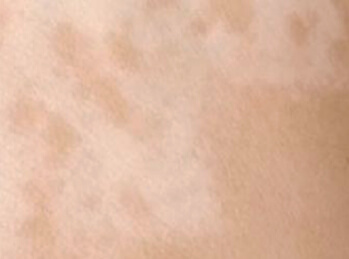
How does Vitiligo feature ?
Vitiligo can affect any part of the body, either as a single patch of skin or as multiple patches.
Exposed area, such as face, neck, eyelids, nostrils or finger tips are more commonly affected.
Body folds, nipples and genitalia are also often affected, but at a lesser extent.
Loss of colour may also affect the hair on the scalp, eyebrows, eyelashes and body.
Emotional stress appears to trigger occurrence of new patches. As the patches themselves are white, the colour of their borders is usually that of normal, non-affected skin. However, it can sometimes be hyper- or hypopigmented, or present with an inflamed red border.
The course of vitiligo is unpredictable, and nobody can tell which will be the final extension of vitiligo and how fast it will occur. The severity and the course of vitiligo are different from one individual to another one. This course is often versatile and capricious: occurrence and then extension of vitiligo can occur over a few months, then it stabilises.
Then spontaneous repigmentation can even occur, or on the contrary at some time in the future, the lesions begin to extend again. Cycles alternating extension of the patches with stability may persist all over the patient’s life, and may finalize as generalized vitiligo, affecting all the body surface.


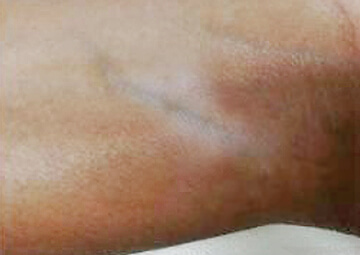
How is Vitiligo classified ?
A consensus was reached in 2007 about the classification of vitiligo.
There are 4 main categories of vitiligo:
– Non-segmental vitiligo, tending to be bilateral and symmetrical in distribution. It may be stable or unstable. Subtypes are focal, mucosal, acrofacial, generalised and universal.
– Segmental vitiligo: in most cases, it features a single white patch. Contours are often irregular, it affects rather young people and becomes stable after one year. Subtypes are focal, mucosal, unisegmental, bi- or multisegmental.
– Mixed vitiligo is rare and features a combination of segmental with non-segmental vitiligo.
– Unclassified vitiligo presents as an early disease, being focal at onset and becoming later multifocal asymmetrical non-segmental and/or unifocal mucosal.
How do physicians assess the severity of Vitiligo ?
There are two scoring systems to formally assess the severity of vitiligo.
Vitiligo Area Scoring Index (VASI) measures the extent and degree of depigmentation in 6 sites: hands, upper extremities, trunk, lower extremities and feet, head/neck.
Vitiligo European Task Force (VETF) system assesses extent, staging and spreading/progression in 5 sites: head/neck, trunk, arms, legs and hands/feet.
Which is the diagnosis of Vitiligo ?
Vitiligo is normally a clinical diagnosis and does not need specific tests.
Wood light (black light) examination makes the white patches more easily visible.
Sometimes blood tests or skin biopsy may be performed.
Photographs may be useful to monitor the extent and evolution of the disease.
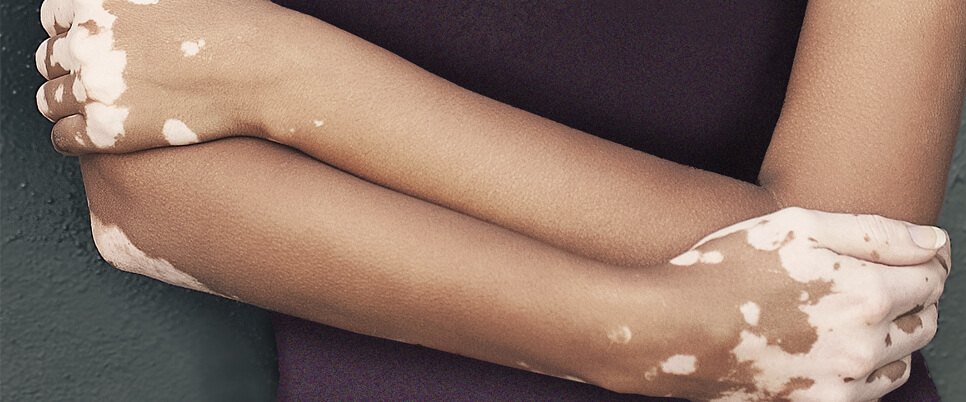

>How do physicians assess the severity of Vitiligo ?
There are two scoring systems to formally assess the severity of vitiligo.
Vitiligo Area Scoring Index (VASI) measures the extent and degree of depigmentation in 6 sites: hands, upper extremities, trunk, lower extremities and feet, head/neck.
Vitiligo European Task Force (VETF) system assesses extent, staging and spreading/progression in 5 sites: head/neck, trunk, arms, legs and hands/feet.
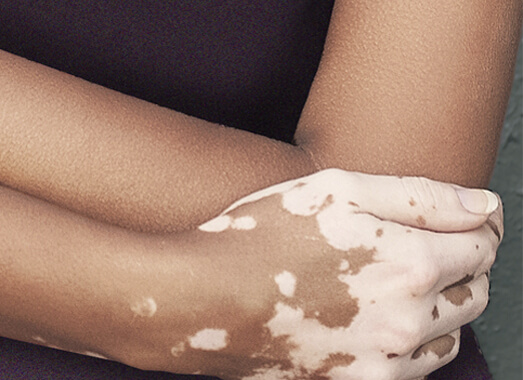
Which are the current treatments for Vitíligo ?
Treatment of vitiligo is currently unsatisfactory and any new option is welcomed.
Any treatment is most successful on face and trunk, hands, feet whilst areas with white hair respond poorly.
Lifestyle measures:
– Avoid wearing stretching clothes, which can injure the skin, provoke friction and increase the risk of vitiligo.
– Wear protective clothing in order to avoid injuries, which can likely lead to a new white patch.
– Vitiligo can be visually attenuated by using cosmetic camouflage, including make-up, dyes, stains, but also self-tanning products.
– Tattooing and permanent make-up may also be useful.
– Wear high SPF sun protector, as tanning of non-lesional skin will increase the contrast with white patches and make vitiligo lesions more visible. White patches only burn and never tan, and a sunburn may provoke the occurrence of new lesions.
Topical medical treatments include:
– Topical corticosteroids can be used for vitiligo on trunk and limbs for up to 3 months.
Avoid application of potent corticosteroids, especially on the face and areas with thinner skin. Keep in mind that long-term use of topical corticosteroids may lead to thinning of the skin in treated areas.
– Topical calcineurin inhibitors (pimecrolimus cream and tacrolimus ointment) may give good results, especially on the face.
– Experimental trials with topical ruxolitinib appears to be promising.
PHOTOTHERAPY
It refers to treatment with ultraviolet (UV) radiation.
It probably works through a double-edge mechanism: immune suppression (prevention of the destruction of the melanocytes) and stimulation of growth factors.
Several options are available: whole-body or localised broadband or narrowband (311 nm) UVB, excimer laser UVB (308 nm) preferably for small areas and oral, topical, or bathwater photochemotherapy (PUVA).
Treatment schedule is usually twice weekly for a trial period of 3–4 months. If repigmentation is observed, treatment is continued until repigmentation is complete or for a maximum period of 1–2 years.
SYSTEMIC THERAPY
These treatments include:
– Oral minocycline, due to its anti-inflammatory properties.
– Mini-pulses of oral steroids for 3 to 6 months.
– Subcutaneous afamelanotide.
SURGICAL TREATMENT
Only suitable for stable vitiligo.
It requires removal of the top layer of vitiligo skin (by shaving, dermabrasion, sandpapering or laser) and replacement with pigmented skin removed from another site.
Including non-cultured melanocyte-keratinocyte cell suspension transplantation, punch grafting, blister grafts, split skin grafting or cultured autografts of melanocytes grown in tissue culture.
DEPIGMENTATION THERAPY
Only considered in severely affected, dark skinned individuals.
Monobenzyl ether of hydroquinone is commonly used, but also cryotherapy and laser treatment.
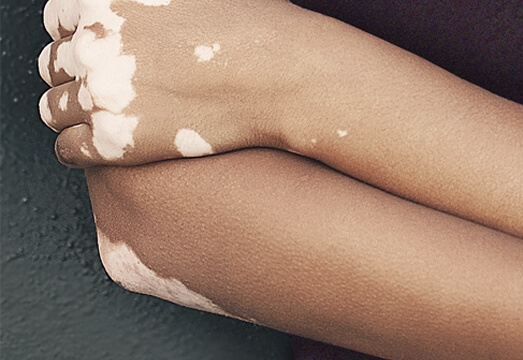
How does Vitiligo affect the patient’s psychology ?
Quality of life is often impaired in vitiligo, especially in young females.
This impairment may be major in some countries, cultures or religions.
Self-esteem is commonly affected and this situation needs psychological support.


